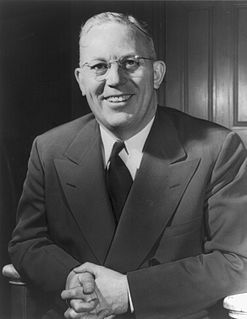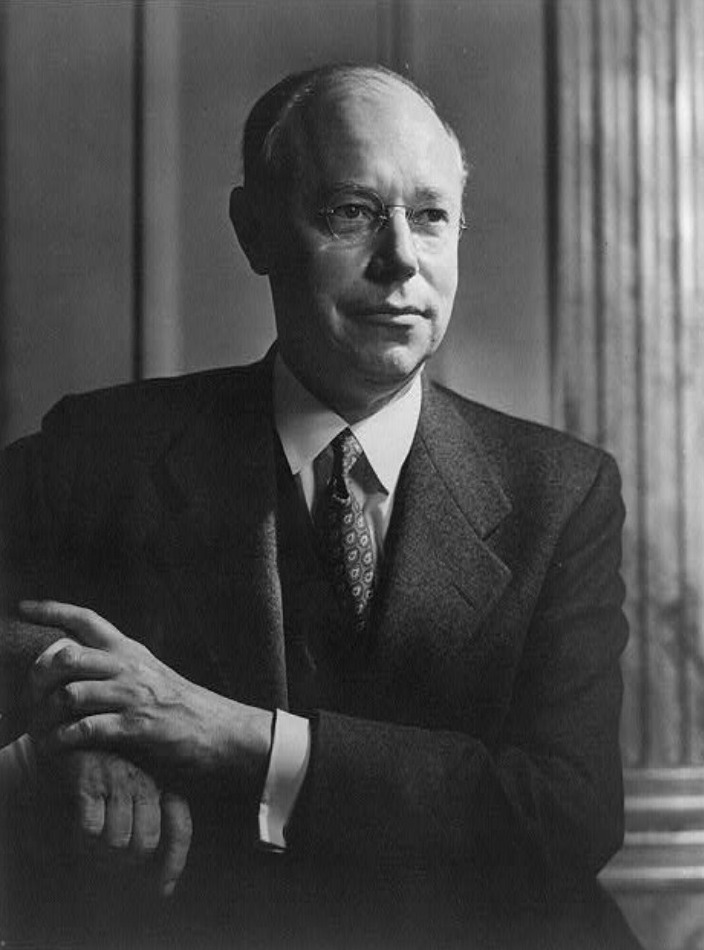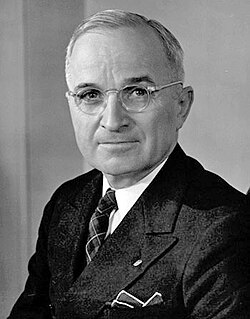
The 1944 United States presidential election was the 40th quadrennial presidential election. It was held on Tuesday, November 7, 1944. The election took place during World War II. Incumbent Democratic President Franklin D. Roosevelt defeated Republican Thomas E. Dewey to win an unprecedented fourth term.

The 1948 United States presidential election was the 41st quadrennial presidential election. It was held on Tuesday, November 2, 1948. Incumbent President Harry S. Truman, the Democratic nominee, defeated Republican Governor Thomas E. Dewey. Truman's victory is considered to be one of the greatest election upsets in American history.

The 1952 United States presidential election was the 42nd quadrennial presidential election. It was held on Tuesday, November 4, 1952. Republican Dwight D. Eisenhower won a landslide victory over Democrat Adlai Stevenson, ending a string of Democratic Party wins that stretched back to 1932.

The 1952 Republican National Convention was held at the International Amphitheatre in Chicago, Cook County, Illinois from July 7 to 11, 1952, and nominated the popular general and war hero Dwight D. Eisenhower of Kansas, nicknamed "Ike," for president and the anti-communist crusading Senator from California, Richard M. Nixon, for vice president.

The 1948 Republican National Convention was held at the Municipal Auditorium, in Philadelphia, Pennsylvania, from June 21 to 25, 1948.
Presidential primaries have been held in the United States since 1912 to nominate the Republican presidential candidate.

The 1952 Republican presidential primaries were the selection process by which voters of the Republican Party chose its nominee for President of the United States in the 1952 U.S. presidential election. Former U.S. Army General Dwight D. Eisenhower was selected as the nominee through a series of primary elections and caucuses culminating in the 1952 Republican National Convention held from July 7 to July 11, 1952, in Chicago, Illinois.

The 1948 Republican presidential primaries were the selection process by which voters of the Republican Party chose its nominee for President of the United States in the 1948 U.S. presidential election. The nominee was selected through a series of primary elections and caucuses culminating in the 1948 Republican National Convention held from June 21 to June 25, 1948, in Philadelphia, Pennsylvania.

The 1948 United States elections was held on November 2, 1948. The election took place during the beginning stages of the Cold War. Democratic incumbent President Harry S. Truman was elected to a full term, defeating Republican nominee New York Governor Thomas E. Dewey and two erstwhile Democrats. The Republicans, who had just won both the House and the Senate two years earlier, ceded control of both chambers of Congress to the Democrats. Puerto Rico also elected Luis Muñoz Marín of the Popular Democratic Party as its first democratically elected governor.

Electoral history of Robert A. Taft, United States Senator from Ohio (1939–1953), United States Senate Majority Leader (1953) and a candidate for 1940, 1948 and 1952 Republican presidential nominations
The Dewey–Stassen debate was the first audio-recorded presidential debate to ever take place in the United States. It featured New York Governor Thomas E. Dewey and former Minnesota Governor Harold Stassen discussing the legal status of Communist Party of the United States four days before the 1948 Oregon Republican presidential primary. The debate transmitted throughout the nation via radio broadcast, and is credited with helping Dewey win the primary and the nomination of his party. It is often cited as establishing the modern presidential debate standard.

The 1944 Republican presidential primaries were the selection process by which voters of the Republican Party chose its nominee for President of the United States in the 1944 U.S. presidential election. The nominee was selected through a series of primary elections and caucuses culminating in the 1944 Republican National Convention held from June 26 to June 28, 1944, in Chicago, Illinois.

The 1948 United States presidential election in New Jersey took place on November 2, 1948. All contemporary 48 states were part of the 1948 United States presidential election. New Jersey voters chose 16 electors to the Electoral College, which selected the president and vice president.

The 1948 United States presidential election in New Hampshire took place on November 2, 1948, as part of the 1948 United States presidential election, which was held throughout all contemporary 48 states. Voters chose four representatives, or electors to the Electoral College, who voted for president and vice president.

This article lists those who were potential candidates for the Democratic nomination for Vice President of the United States in the 1948 election. At the 1948 Democratic National Convention, President Harry S. Truman won nomination to a full term. Truman had become president upon the death of his predecessor and 1944 running mate, Franklin D. Roosevelt. As the 25th Amendment had not yet been passed, there was no method for filling a vice presidential vacancy, and Truman served without a vice president during his first term. Truman's nomination faced significant opposition from the South, as did the party's platform on civil rights. Though Truman attempted to convince Supreme Court Justice William O. Douglas to join the ticket, Douglas declined. Truman instead selected Senate Minority Leader Alben W. Barkley, the preferred choice of many Democratic delegates, and a border state Senator who could appeal to both the Northern and Southern wings of the party. The Truman-Barkley ticket won the 1948 election, defeating the Republican (Dewey-Warren), Progressive (Wallace-Taylor), and Dixiecrat (Thurmond-Wright) tickets.

This article lists those who were potential candidates for the Republican nomination for Vice President of the United States in the 1952 election. After defeating Ohio Senator Robert A. Taft for the Republican presidential nomination at the 1952 Republican National Convention, General Dwight D. Eisenhower needed to choose a running mate. Taft recommended Illinois Senator Everett Dirksen, but Eisenhower rejected the suggestion. Eisenhower and his advisers put together a list of prominent Republicans who were acceptable to both the conservative Taft and liberal Dewey wings of the party, anti-Communist, talented at campaigning, relatively young, and who contributed to Eisenhower's nomination victory. After conferring with Republican Party leaders, Eisenhower decided to ask California Senator Richard Nixon to be his running mate; Nixon accepted the offer. Nixon had carefully campaigned for the post of vice president since meeting Eisenhower in 1951, and Nixon helped deliver the California delegation to Eisenhower in the presidential ballot. The Republican convention ratified Eisenhower's choice of Nixon. Months after the convention, Eisenhower considered asking Nixon to step down as running mate due to controversy surrounding campaign expenses, but Nixon rallied public opinion with his Checkers speech and remained on the ticket. The Eisenhower-Nixon ticket won the 1952 election, as well as the 1956 election, defeating the Stevenson-Sparkman and Stevenson-Kefauver tickets, respectively.

This article lists those who were potential candidates for the Republican nomination for Vice President of the United States in the 1944 election. At the start of the 1944 Republican National Convention, New York Governor Thomas Dewey seemed like the likely presidential nominee, but his nomination was not assured due to strong support for Ohio Governor John W. Bricker and former Minnesota Governor Harold Stassen. Though Dewey wanted California Governor Earl Warren as his running mate, Warren was convinced that Franklin D. Roosevelt would win re-election, and refused to be anyone's running mate. Some Republicans wanted to ask Democratic Senator Harry Byrd of Virginia to be the Republican running mate in order to pursue the Southern vote, but this possibility was not seriously pursued. Dewey and his advisers instead worked out a deal in which Bricker's delegates voted for Dewey in the presidential ballot, and Dewey in return chose Bricker as his running mate. The Dewey-Bricker ticket, which balanced the moderate Northeastern and conservative Midwestern wings of the party, was ratified by the Republican convention. The ticket lost the 1944 presidential election to the ticket of Franklin D. Roosevelt and Harry S. Truman.

The 1948 United States presidential election in Kentucky took place on November 2, 1948, as part of the 1948 United States presidential election. Kentucky voters chose eleven representatives, or electors, to the Electoral College, who voted for president and vice president.



















